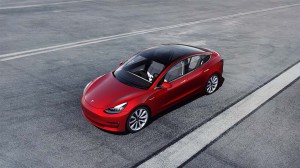
The Tesla Model 3 is now the best-selling product in the Netherlands and among the top five in the UK.
During a news conference in Washington on Thursday, U.S. Department of Transportation Sec. Elaine Chao derided EVs as “cars that American consumers do not want to buy or drive.”
True, all forms of electrified vehicles – from conventional hybrids up to pure battery-electric models – account for barely 5% of the U.S. market, but those numbers have been surging. Demand for plug-based models alone rose 5%, to 200,194, during the first eight months of this year, despite the overall downturn in the American market.
One has to look elsewhere to see how battery-cars are really showing their potential, however. According to industry data, global demand is accelerating at a far more rapid pace and, in several markets, EVs are beginning to dominate conventionally powered vehicles.
(Amazon orders 100,000 Rivian battery-powered delivery trucks. Click Here for the full story.)
Worldwide, reports InsideEVs, 1,253,549 million plug-based vehicles were sold through the end of July, a 139.6% increase over the 897,665 PHEVs and BEVs purchased during the same period in 2018.
And those numbers underplay the significant growth in acceptance in key markets, such as Europe and China, by including not only the U.S. but other regions of the world where electrified vehicles may not be available – or only in limited numbers.
China has become the world’s largest market for plug-based vehicles, demand running about 6.1% of the industry total, and spurred by the country’s New Energy Vehicles, or NEV, mandate. Government-funded incentives also have helped. Sales actually have slipped this year – declining again in July by 7% — though that should be no surprise considering the overall slump in the Chinese automotive market which shows no sign of easing up.
Things are looking a lot more promising in Europe where sales of electric vehicles are expected to hit “at least 1,000,000” in 2020, according to InsideEVs. And that’s supported by trends in several of the EU’s regional markets.
In Norway, plug-ins hold their highest market share in the world, climbing from just 1% in 2014 to 49.1% for all of 2018. And, according to the Rystad, an energy consultancy based in Oslo, the figure topped 55% of personal vehicles for the first half of this year – though slightly less than half when fleets are factored in.
(As a footnote, Norwegian EVs are among the world’s cleanest vehicles, notes the Norwegian Centre for Transportation Research, because 98% of the country’s electricity comes from hydropower.)
(Norway isn’t the only European country embracing battery power, however. The Netherlands, where bicycles are nearly as numerous as cars during rush hour, has also plugged in. As in Norway, much of the EV growth comes from sales of the Tesla Model 3 – the 10,000th of those sedans registered on September 17th, according to Dutch media reports. In fact, the Model 3 is now the single most frequently registered new vehicle in the country, nudging aside the Volkswagen Polo hatchback in recent months.
(You may get the option to choose what your EV sounds like. Click Here to find out why.)
Tesla has been driving demand pretty much everywhere its products are available. Demand in Germany are up 400% so far this year, and industry data show the Model 3 among the top five most popular vehicles of all forms in the United Kingdom.
If one were only looking at market share, DOT Sec. Elaine Chao might also dismiss European battery-car sales as something the public does not want to buy or drive. Overall, plug-based vehicles accounted for just 2.9% of the market for the first seven months of the year, meaning gas and diesel-powered models remain overwhelmingly dominant. But the trendline is what is noteworthy. All plug-in models together saw growth of 34% during that period, according to industry data, with pure battery-electric vehicles gaining an impressive 90 percent.
And consumers will have more reasons to plug in over the coming months as a flood of new models roll into showrooms. That includes the recently unveiled Porsche Taycan sports car and the ID.3, Volkswagen’s first long-range, mainstream-priced model. There’ll be plenty more alternatives giving Tesla a run for its money by this time next year.



They are selling but mostly in countries with the biggest subsidies